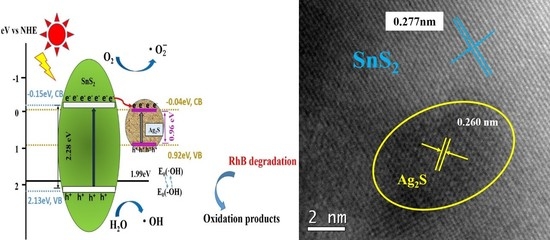Ag2S Quantum Dots Based on Flower-like SnS2 as Matrix and Enhanced Photocatalytic Degradation
Abstract
:1. Introduction
2. Experimental Procedure
2.1. Preparation of the Ag2S@SnS2 Composites
2.2. Characterization
2.3. Measurement of Photocatalytic Activity
3. Results and Discussion
3.1. Structure Analysis
3.2. Morphology Analysis
3.3. UV-vis Analysis
3.4. XPS Analysis
3.5. PL Analysis
3.6. The Commission International DeI’Eclairage (CIE) Chromaticity Diagram Analysis
3.7. Photocatalytic Analysis
3.8. The Probable Photocatalytic Mechanism
4. Conclusions
Author Contributions
Funding
Conflicts of Interest
References
- Rodriguez-Narvaez, O.M.; Peralta-Hernandez, J.M.; Goonetilleke, A.; Bandala, E.R. Treatment technologies for emerging contaminants in water: A review. Chem. Eng. J. 2017, 323, 361–380. [Google Scholar] [CrossRef]
- Zhang, X.; Zhang, P.; Wang, L.; Gao, H.; Zhao, J.; Liang, C.; Hu, J.; Shao, G. Template-oriented synthesis of monodispersed SnS2 @SnO2 hetero-nanoflowers for Cr (VI) photoreduction. Appl. Catal. B 2016, 192, 17–25. [Google Scholar] [CrossRef]
- Lei, Y.; Song, S.; Fan, W.; Xing, Y.; Zhang, H. Facile Synthesis and Assemblies of Flowerlike SnS2 and In3+ -Doped SnS2: Hierarchical Structures and Their Enhanced Photocatalytic Property. J. Phys. Chem. C 2009, 113, 1280–1285. [Google Scholar] [CrossRef]
- Shown, I.; Samireddi, S.; Chang, Y.-C.; Putikam, R.; Chang, P.-H.; Sabbah, A.; Fu, F.-Y.; Chen, W.-F.; Wu, C.-I.; Yu, T.-Y.; et al. Carbon-doped SnS2 nanostructure as a high-efficiency solar fuel catalyst under visible light. Nat. Commun. 2018, 9. [Google Scholar] [CrossRef] [PubMed]
- Chen, L.; Chen, M.; Jiang, D.; Xie, J. A facile strategy for SnS2 /g-C3N4 heterojunction composite and the mechanism in photocatalytic degradation of MO. J. Mol. Catal. A Chem. 2016, 425, 174–182. [Google Scholar] [CrossRef]
- Derikvandi, H.; Nezamzadeh-Ejhieh, A. A comprehensive study on enhancement and optimization of photocatalytic activity of ZnS and SnS2: Response Surface Methodology (RSM), n-n heterojunction, supporting and nanoparticles study. J. Photochem. Photobiol. A 2017, 348, 68–78. [Google Scholar] [CrossRef]
- Gao, X.; Huang, G.; Gao, H.; Pan, C.; Wang, H.; Yan, J.; Liu, Y.; Qiu, H.; Ma, N.; Gao, J. Facile fabrication of Bi2S3/SnS2 heterojunction photocatalysts with efficient photocatalytic activity under visible light. J. Alloys Compd. 2016, 674, 98–108. [Google Scholar] [CrossRef]
- Shen, S.; Yao, Y.; Wang, B.; Chang, Y.; Zhi, L. Synthesis of SnS2 /SnS Heterojunction and Their Enhanced Photocatalytic Properties Under Visible Light. Sci. Adv. Mater. 2015, 7, 1071–1075. [Google Scholar] [CrossRef]
- Amroun, M.N.; Khadraoui, M.; Miloua, R.; Kebbab, Z.; Sahraoui, K. Investigation on the structural, optical and electrical properties of mixed SnS2-CdS thin films. Optik 2017, 131, 152–164. [Google Scholar] [CrossRef]
- Mu, J.; Miao, H.; Liu, E.; Chen, L.; Feng, J.; Han, T.; Gao, Y.; Fan, J.; Hu, X. Using Al2O3 defect levels to enhance the photoelectrocatalytic activity of SnS 2 nanosheets. Ceram. Int. 2017, 43, 4992–5001. [Google Scholar] [CrossRef]
- Zhang, Y.C.; Yao, L.; Zhang, G.; Dionysiou, D.D.; Li, J.; Du, X. One-step hydrothermal synthesis of high-performance visible-light-driven SnS2/SnO2 nanoheterojunction photocatalyst for the reduction of aqueous Cr(VI). Appl. Catal. B 2014, 144, 730–738. [Google Scholar] [CrossRef]
- Yuan, X.; Wang, H.; Wu, Y.; Chen, X.; Zeng, G.; Leng, L.; Zhang, C. A novel SnS2–MgFe2O4/reduced graphene oxide flower-like photocatalyst: Solvothermal synthesis, characterization and improved visible-light photocatalytic activity. Catal. Commun. 2015, 61, 62–66. [Google Scholar] [CrossRef]
- Chen, J.; Liu, S.; Zhang, L.; Chen, N. New SnS2/La2Ti2O7 heterojunction photocatalyst with enhanced visible-light activity. Mater. Lett. 2015, 150, 44–47. [Google Scholar] [CrossRef]
- Qiu, F.; Li, W.; Wang, F.; Li, H.; Liu, X.; Sun, J. In-situ synthesis of novel Z-scheme SnS2 /BiOBr photocatalysts with superior photocatalytic efficiency under visible light. J. Colloid Interface Sci. 2017, 493, 1–9. [Google Scholar] [CrossRef] [PubMed]
- Meng, H.; Wang, T.; Chen, H.; Liu, Y.; Yu, X.; Zhu, Y.; Zhang, Y. BiOCl/SnS2 Core-Shell Photocatalyst for the Degradation of Organic Pollutants. Nano 2016, 11, 1650087. [Google Scholar] [CrossRef]
- Zhang, Y.; Zhao, N.; Qin, Y.; Wu, F.; Xu, Z.; Lan, T.; Cheng, Z.; Zhao, P.; Liu, H. Affibody-functionalized Ag2S quantum dots for photoacoustic imaging of epidermal growth factor receptor overexpressed tumors. Nanoscale 2018, 10, 16581–16590. [Google Scholar] [CrossRef]
- Jing, L.; Xu, Y.; Zhang, M.; Xie, M.; Xu, H.; He, M.; Liu, J.; Huang, S.; Li, H. Novel Ag2S quantum dot modified 3D flower-like SnS 2 composites for photocatalytic and photoelectrochemical applications. Inorg. Chem. Front. 2018, 5, 63–72. [Google Scholar] [CrossRef]
- Zhao, W.; Wei, Z.; Zhang, L.; Wu, X.; Wang, X. Cr doped SnS2 nanoflowers: Preparation, characterization and photocatalytic decolorization. Mater. Sci. Semicond. Process. 2018, 88, 173–180. [Google Scholar] [CrossRef]
- Liu, Y.; Geng, P.; Wang, J.; Yang, Z.; Lu, H.; Hai, J.; Lu, Z.; Fan, D.; Li, M. In-situ ion-exchange synthesis Ag2S modified SnS2 nanosheets toward highly photocurrent response and photocatalytic activity. J. Colloid Interface Sci. 2018, 512, 784–791. [Google Scholar] [CrossRef]
- Kar, S.; Chaudhuri, S. Synthesis and optical properties of single and bicrystalline ZnS nanoribbons. Chem. Phys. Lett. 2005, 414, 40–46. [Google Scholar] [CrossRef]
- Biswas, S.; Kar, S.; Chaudhuri, S. Optical and Magnetic Properties of Manganese-Incorporated Zinc Sulfide Nanorods Synthesized by a Solvothermal Process. J. Phys. Chem. B 2005, 109, 17526–17530. [Google Scholar] [CrossRef] [PubMed]
- Khan, W.S.; Cao, C.; Ali, Z.; Butt, F.K.; Ahmad Niaz, N.; Baig, A.; ud Din, R.; Farooq, M.H.; Wang, F.; ul Ain, Q. Solvo-solid preparation of Zn3N2 hollow structures; their PL yellow emission and hydrogen absorption characteristics. Mater. Lett. 2011, 65, 2127–2129. [Google Scholar] [CrossRef]
- Deshpande, N.G.; Sagade, A.A.; Gudage, Y.G.; Lokhande, C.D.; Sharma, R. Growth and characterization of tin disulfide (SnS2) thin film deposited by successive ionic layer adsorption and reaction (SILAR) technique. J. Alloys Compd. 2007, 436, 421–426. [Google Scholar] [CrossRef]
- Ye, Y.; Yang, H.; Wang, X.; Feng, W. Photocatalytic, Fenton and photo-Fenton degradation of RhB over Z-scheme g-C3 N 4 /LaFeO 3 heterojunction photocatalysts. Mater. Sci. Semicond. Process. 2018, 82, 14–24. [Google Scholar] [CrossRef]
- Nosaka, Y.; Nosaka, A.Y. Generation and Detection of Reactive Oxygen Species in Photocatalysis. Chem. Rev. 2017, 117, 11302–11336. [Google Scholar] [CrossRef] [PubMed]
- Di Credico, B.; Bellobono, I.R.; D’Arienzo, M.; Fumagalli, D.; Redaelli, M.; Scotti, R.; Morazzoni, F. Efficacy of the Reactive Oxygen Species Generated by Immobilized TiO2 in the Photocatalytic Degradation of Diclofenac. Int. J. Photoenergy 2015, 2015, 1–13. [Google Scholar] [CrossRef]
- Di Credico, B.; Redaelli, M.; Bellardita, M.; Calamante, M.; Cepek, C.; Cobani, E.; D’Arienzo, M.; Evangelisti, C.; Marelli, M.; Moret, M.; et al. Step-by-Step Growth of HKUST-1 on Functionalized TiO2 Surface: An Efficient Material for CO2 Capture and Solar Photoreduction. Catalysts 2018, 8, 353. [Google Scholar] [CrossRef]
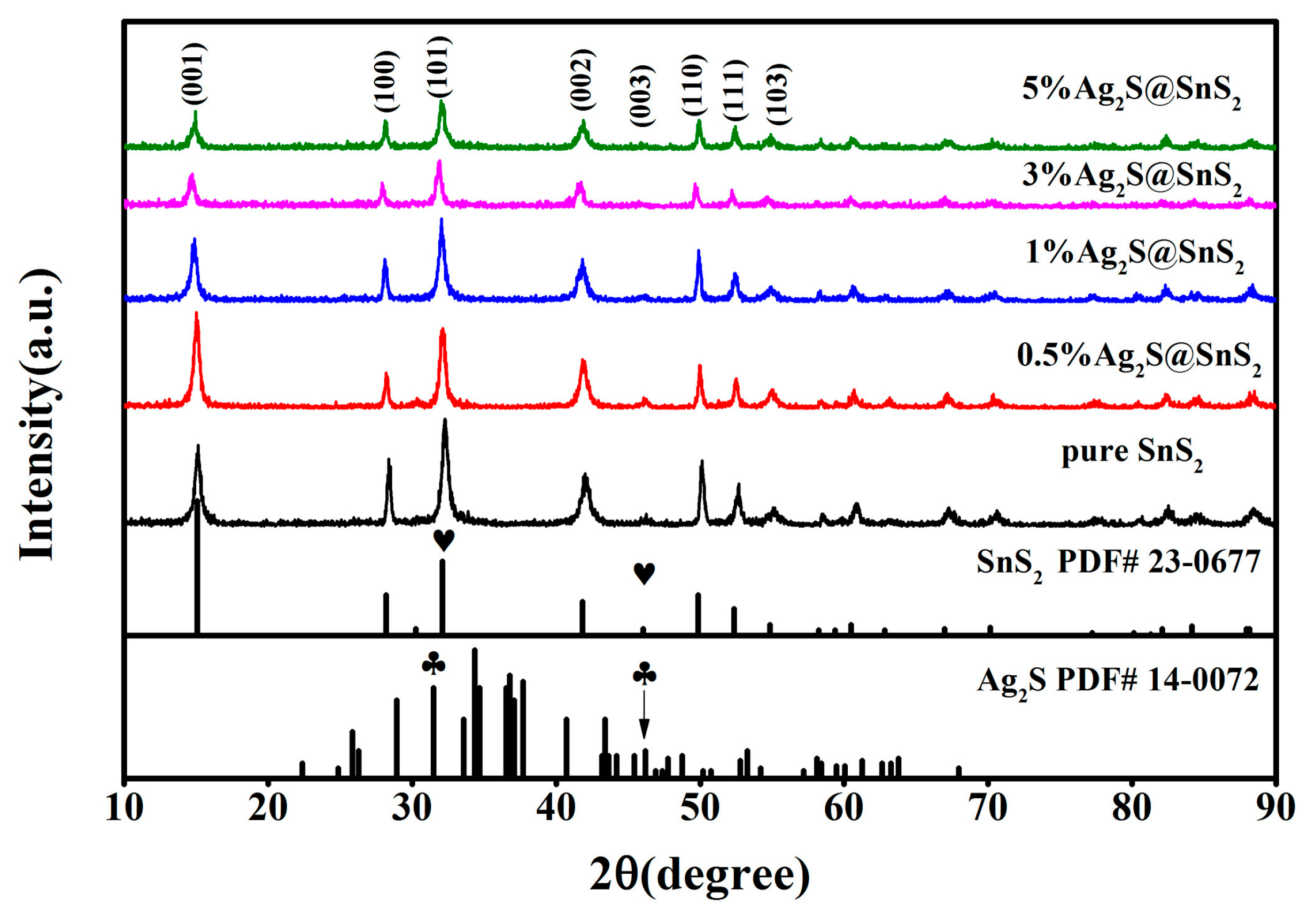

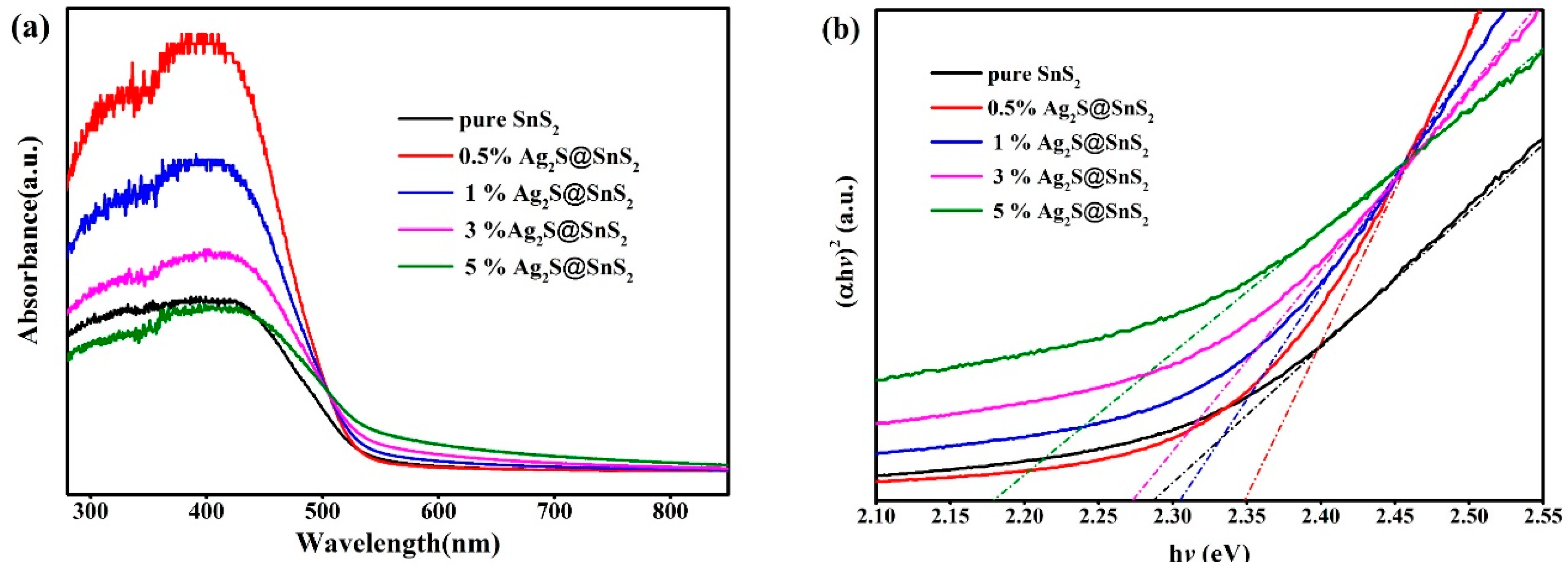
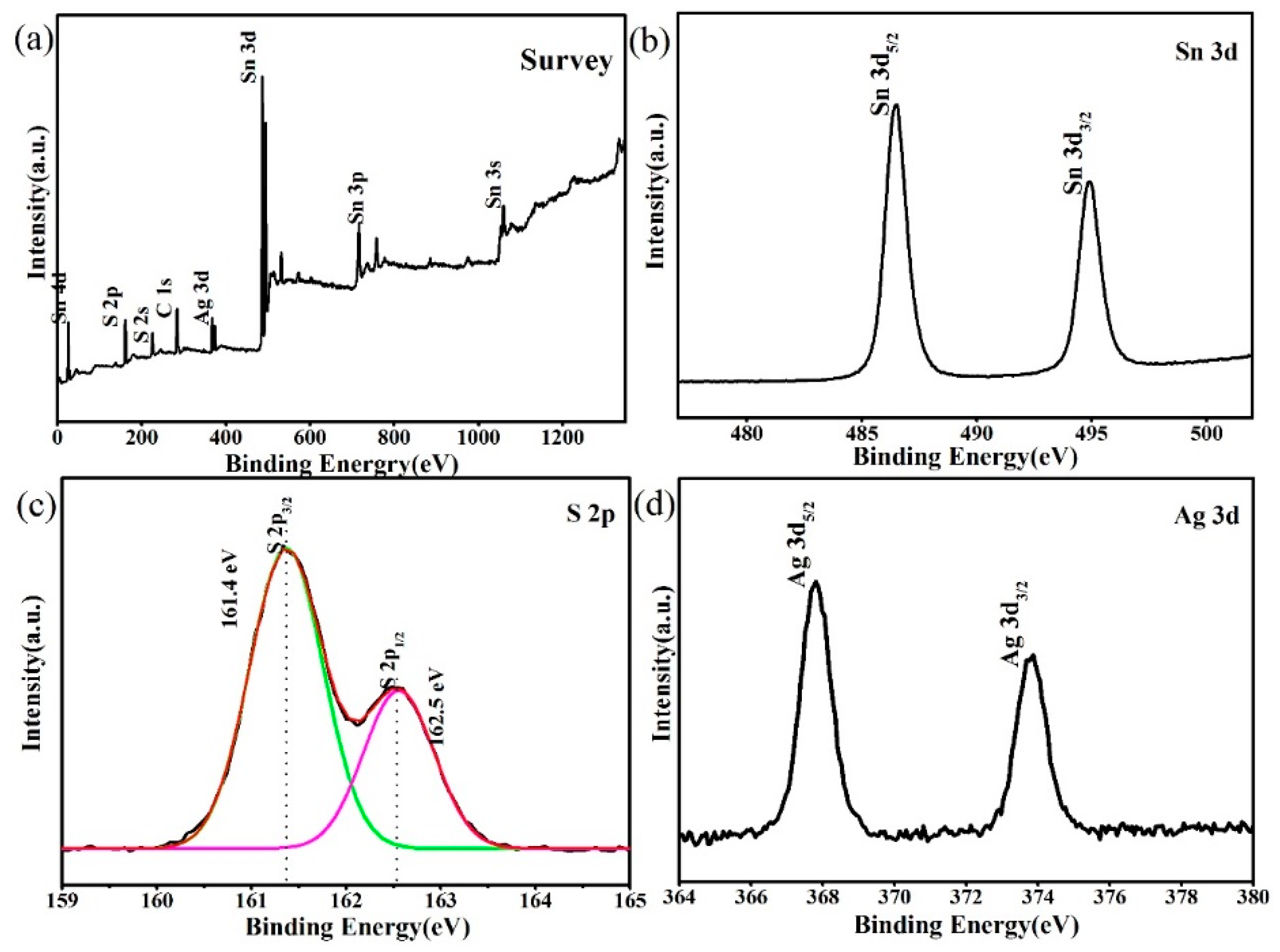
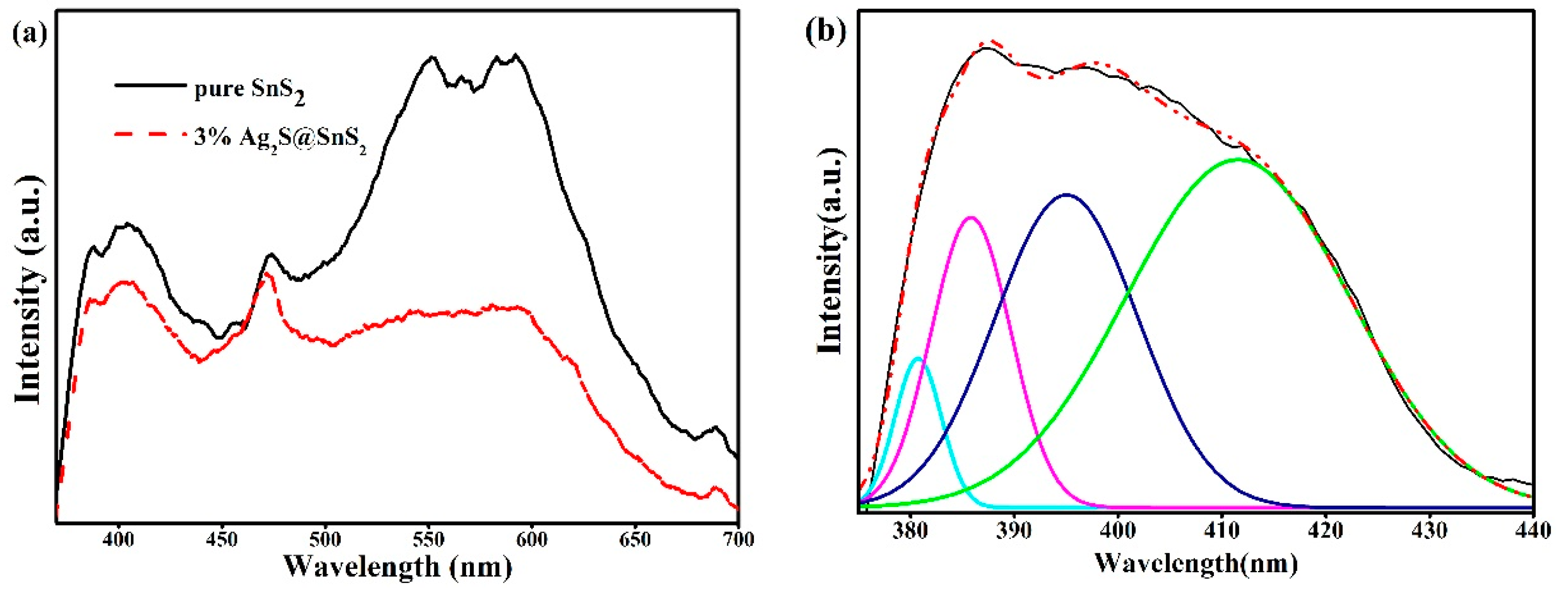
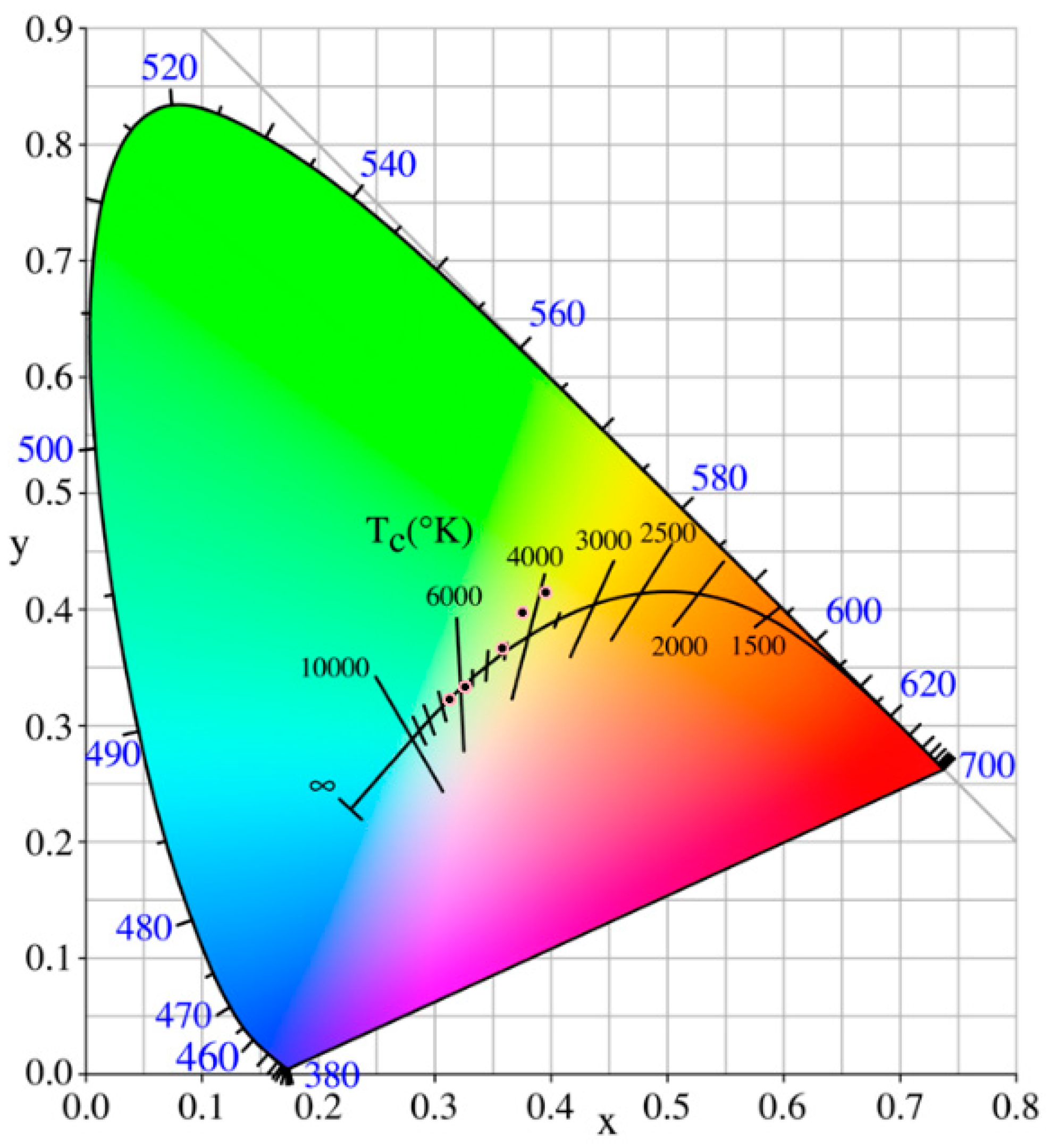

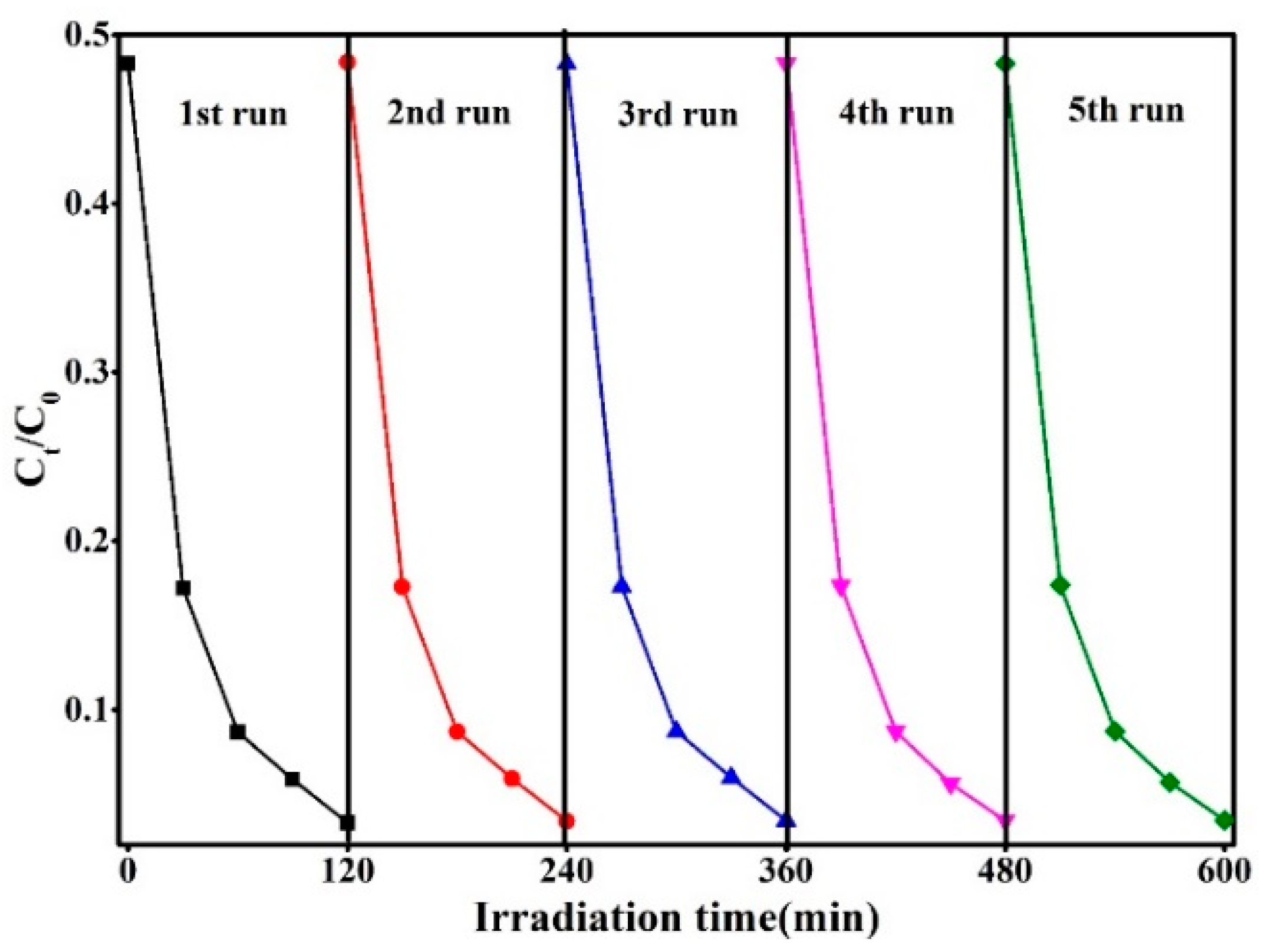
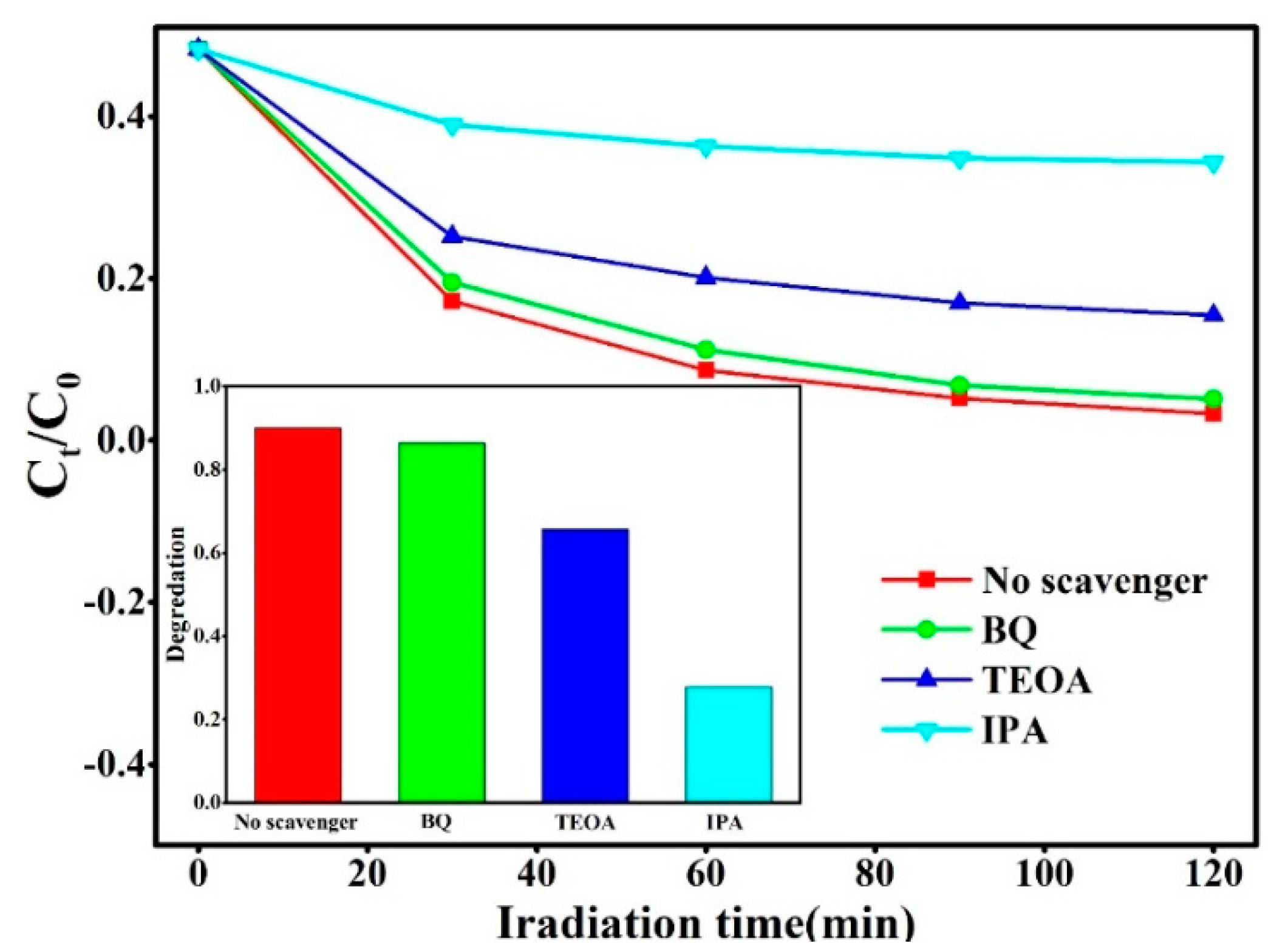
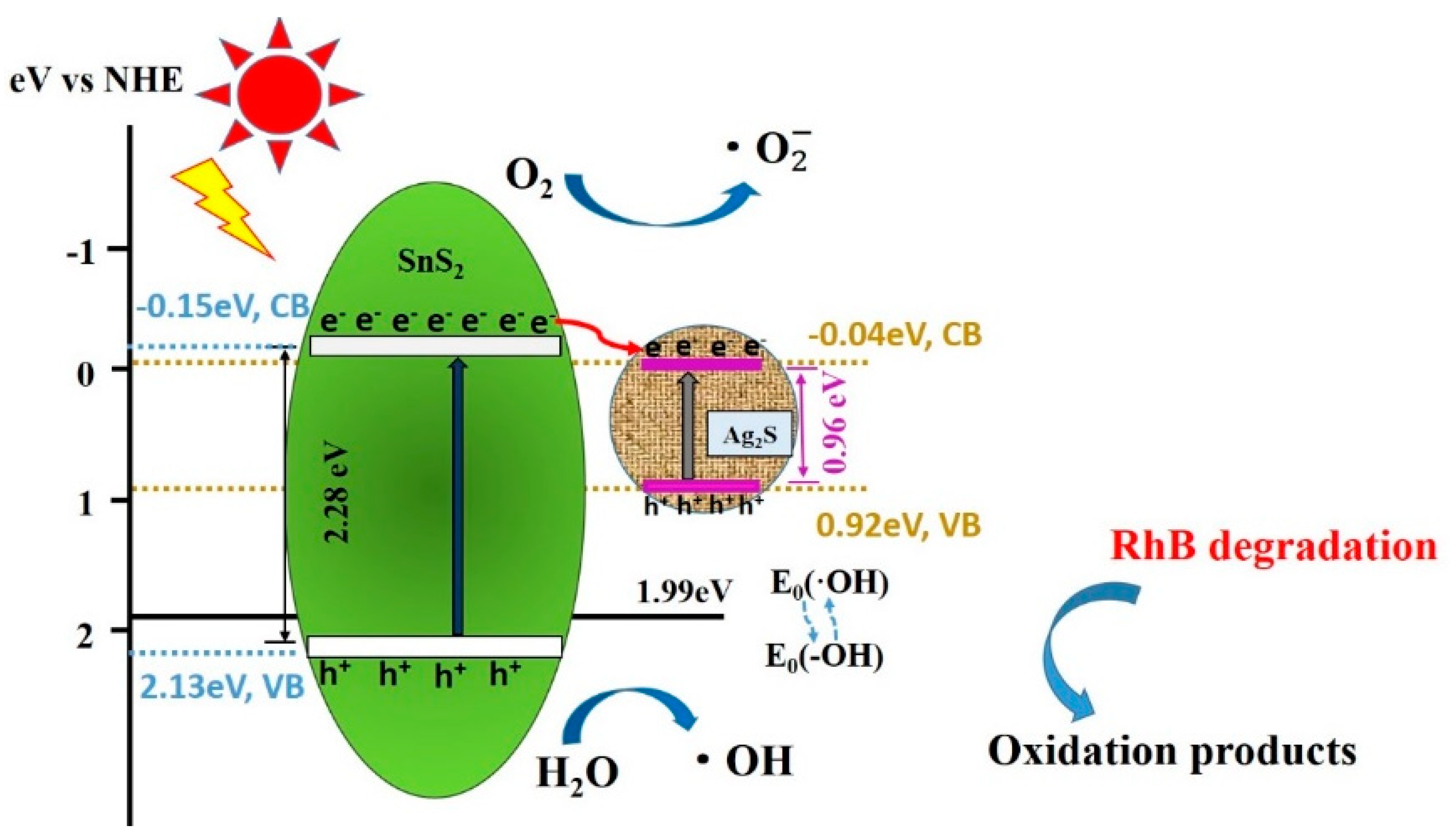
| Samples | X | Y | Peak Position (nm) | Intensity (a.u.) |
|---|---|---|---|---|
| pure SnS2 | 0.3593 | 0.3670 | 577 | 12.59 |
| 0.5%Ag2S@SnS2 | 0.3954 | 0.4152 | 588 | 42.67 |
| 1%Ag2S@SnS2 | 0.3754 | 0.3975 | 591 | 30.97 |
| 3%Ag2S@SnS2 | 0.3262 | 0.3327 | 404 | 9.3 |
| 5%Ag2S@SnS2 | 0.3128 | 0.3224 | 403 | 15.08 |
© 2019 by the authors. Licensee MDPI, Basel, Switzerland. This article is an open access article distributed under the terms and conditions of the Creative Commons Attribution (CC BY) license (http://creativecommons.org/licenses/by/4.0/).
Share and Cite
Zhao, W.; Wei, Z.; Ma, L.; Liang, J.; Zhang, X. Ag2S Quantum Dots Based on Flower-like SnS2 as Matrix and Enhanced Photocatalytic Degradation. Materials 2019, 12, 582. https://doi.org/10.3390/ma12040582
Zhao W, Wei Z, Ma L, Liang J, Zhang X. Ag2S Quantum Dots Based on Flower-like SnS2 as Matrix and Enhanced Photocatalytic Degradation. Materials. 2019; 12(4):582. https://doi.org/10.3390/ma12040582
Chicago/Turabian StyleZhao, Wenhua, Zhiqiang Wei, Long Ma, Jiahao Liang, and Xudong Zhang. 2019. "Ag2S Quantum Dots Based on Flower-like SnS2 as Matrix and Enhanced Photocatalytic Degradation" Materials 12, no. 4: 582. https://doi.org/10.3390/ma12040582



